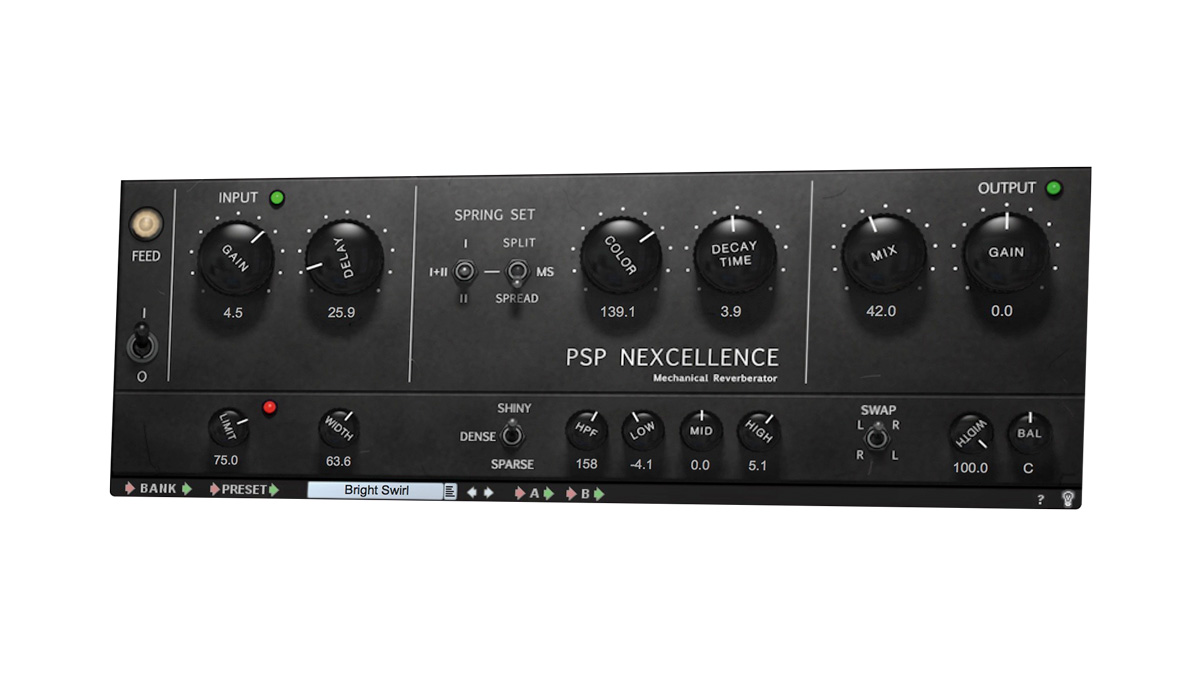MusicRadar Verdict
If you yearn for something genuinely different in your reverb folder, Nexcellence is well worth springing for.
Pros
- +
Two spring models for creative scope.
- +
Sumptuous, realistic ‘analogue’ sound.
- +
Beautiful interface.
Cons
- -
Quite expensive.
- -
No bypass switch to accompany Feed.
MusicRadar's got your back
Modelling the necklace-type spring reverbs briefly found in Hammond organs (see The rights of springs), Nexcellence (VST/AU/AAX/RTAS) departs from classic reverb ‘norm’ in its architecture and style.
The Input Gain knob can be raised to boost or overdrive the input signal, while the Limit knob below lowers the threshold on an opto-limiter circuit. Between them, these two enable a high degree of dynamic and saturation control at the input. The Feed switch kills the input to the reverb, but not the reverb itself - very handy, but a regular bypass button wouldn’t go amiss, too.
Up to 250ms of predelay is on tap via the Delay knob, while lowering the Input Width pulls down the gain of the sides signal.
Nexcellence simultaneously models two discrete spring sets, the idea being to use them individually or together. To that end, each has its own particular yet complementary character. Set I is the brighter of the two, with a bit more sustain and depth – ‘newer’, if you will. Set II is darker and tighter - ‘older’, we’d say.
The two spring sets are configurable in three modes: set I on its own, set II on its own, or both together (I+II). In I and II modes, the input is summed to mono before entering the reverb. In I+II mode, the stereo input channel assignment is switchable between three settings. Split has spring set I processing the left channel and set II the right. In M/S mode, set I processes the mid, set II processes the sides, and the two are decoded to L/R at the output. In Spread mode, both spring sets receive input from both channels. The Swap switch, unsurprisingly, switches the channels.
Invented by the Hammond Organ Company in the late 1950s specifically to accompany their own instruments, the necklace reverb was a lower-priced, smaller and much better sounding alternative to the oilcan spring reverbs that came before it.
Three springs of differing length were strung across the horizontal bar of a T-shaped frame, like a necklace, the shortest at the top, the longest at the bottom. The signal from the input transducer caused the springs to oscillate independently of each other, yielding a complex ‘modulated’ sound as the vibration from each one arrived at the output transducer on its own ‘timeline’.
Although it sounded fantastic, sadly the necklace reverb wasn’t around for long. The tendency for those loosely hanging springs to make horrendous clattering noises when shaken by accidental contact or heavy on-stage vibration saw it quickly supersed by tensioned dual-spring models.
For shaping of the reverb itself, Nexcellence offers Decay Time, Color and EQ controls. Above all that, three Density settings - Sparse, Dense and Shiny - balance CPU overhead with accuracy (ie, oversampling). Shiny is about 50% heavier than Sparse, but the improvement in high-frequency presence and depth is apparent.
Decay Time ranges from 0.8-7s, but being a true mechanical - and thus non-linear - model, the actual time depends on the frequency content and level of the input signal, and the Color setting. Color governs not only the high- frequency tilt of the tail but also its density and saturation, again influenced by the properties of the input signal.
Want all the hottest music and gear news, reviews, deals, features and more, direct to your inbox? Sign up here.
The EQ comprises a high-pass filter (10Hz-1kHz), and Low (60Hz), Mid (1.3kHz) and High (6kHz) gain knobs, each delivering 12dB of fairly broad cut or boost to the wet signal.
Finally, the output signal is dry/wet mixed, levelled, narrowed and panned at the right hand end of the interface.
Next gen
Nexcellence is quite unlike any reverb - spring or otherwise - you’ve ever heard, with a unique richness and energy. We love the inexactness of the Decay Time and Color parameters, which encourage setting by ear rather than eye, and the routing configurability of the two springs presents plenty of scope in terms of sonic variation and complexity.
Most importantly, it just sounds fabulous on any source - acoustic, vocal, electric or electronic - adding evocative ambience, smooth spatialising or full-on dub-style ‘sproing’. Don’t make the mistake of writing this one off as a vintage curio - Nexcellence is just shy of essential.
Computer Music magazine is the world’s best selling publication dedicated solely to making great music with your Mac or PC computer. Each issue it brings its lucky readers the best in cutting-edge tutorials, need-to-know, expert software reviews and even all the tools you actually need to make great music today, courtesy of our legendary CM Plugin Suite.

